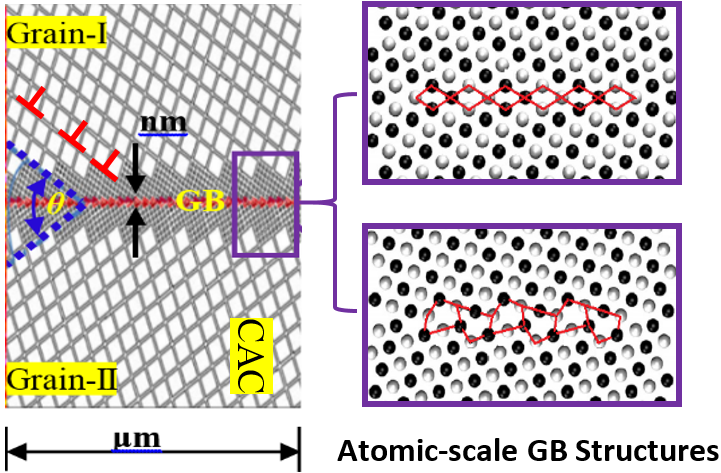Research Areas:
Link Atomistic to Continuum
[Read more...]
CG Simulation of Dislocations
[Read more...]
Multiscale Thermal Transport
[Read more...]
Dislocation-Interface Interactions
Bio-inspired Composites
[Read more...]
Materials under Irradiations
[Read more...]
Brittle-to-Ductile Fracture
[Read more...]
High-pressure Phase Transitions
[Read more...]
Nanostructured Ceramics
[Read more...]
Dislocation-interfaces interactions play a key role in determining the plasticity of heterogeneous materials. The mechanism of dislocation-interface reactions can be very complicated in materials with a complex interfacial microstructure. For example, in our group, the recent atomistic simulations show that dislocations pile up at a GB, but are absorbed by a triple GB junctions (movies as shown on the right). Experimental observations imply that both the atomic-scale interface structural evolution and the long-range fields of dislocation pile-ups come into play during the dislocation-interfaces reactions. As such, our concurrent atomistic-continuum (CAC) method, which accounts for both long distance dislocation migration at the micrometer level and the interface structure evolution at the atomic level, is perfectly applicable to address such a multiscale problem.
Interaction between Dislocations and a Grain Boundary (Rigelesaiyin and Xiong, 2016)
Interaction between Dislocations and a Triple Junction (Rigelesaiyin and Xiong, 2016)

In CAC models, the interface is fully resolved at atomic scale and the domain away from the interface is in a coarse-grained (CG) atomistic description, where the dislocations nucleation and migration can be accommodated with a significantly less number of degree-of-freedom than that in full molecular dynamics (MD) simulations or the other adaptive multiscale methods. A variety of atomic-scale interface structures, such as the various tilt GBs as shown in the figures above, can be naturally incorporated into the CAC model to predict the detailed dislocation-interface reactions in a micron-sized specimen. The following figures demonstrate the capability of CAC in predicting a sequential dislocation pile-ups on a twin boundary in copper by a recent large-scale CAC simulation.

References:
- Chen, X., Xiong, L., Chernatynskiy, A., and Chen, Y., 2014. A molecular dynamics study of tilt grain boundary resistance to slip and heat transfer in nanocrystalline silicon, Journal of Applied Physics, 116, 244309. http://dx.doi.org/10.1063/1.4905248
- Xu, S., Xiong, L., Chen, Y., and McDowell, D.L., 2016. Sequential slip transfer of mixed-character dislocations across Σ3 coherent twin boundary in fcc metals: a concurrent atomistic-continuum study, npj Computational Materials, 2, 15016. doi:10.1038/npjcompumats.2015.16
